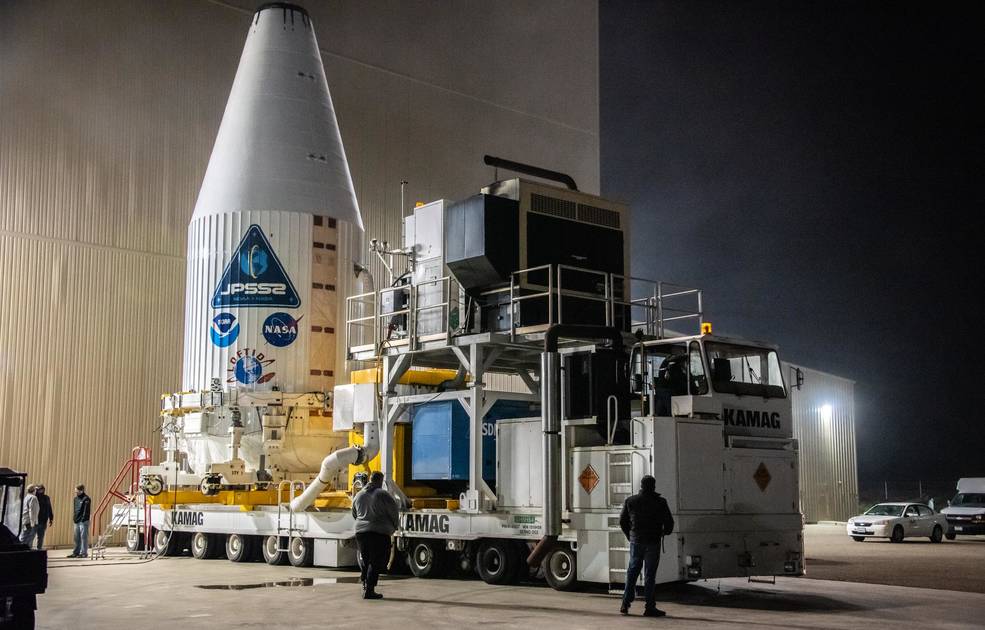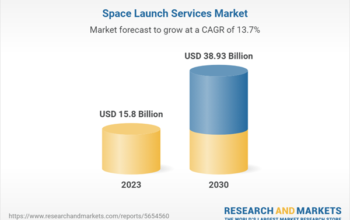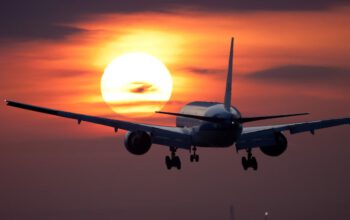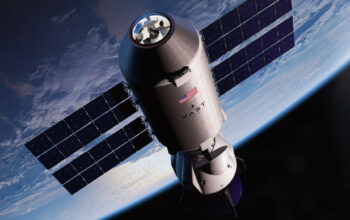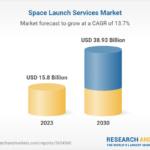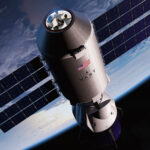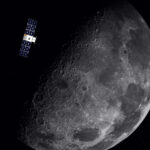NASA will provide coverage of the upcoming prelaunch and launch activities for the National Oceanic and Atmospheric Administration's (NOAA's) Joint Polar Satellite System-2 (JPSS-2) mission and NASA's Low-Earth Orbit Flight Test of an Inflatable Decelerator (LOFTID) technology demonstration.
Liftoff is scheduled at 1:25 a.m. PST (4:25 a.m. EST) Thursday, Nov. 10, on a United Launch Alliance (ULA) Atlas V 401 rocket from Space Launch Complex 3 at Vandenberg Space Force Base in California.
Source: NASA
Picture: The United Launch Alliance Atlas V payload fairing containing the National Oceanic and Atmospheric Administration's (NOAA) Joint Polar Satellite System-2 (JPSS-2) is readied for its move to the vertical integration facility at Space Launch Complex 3 at Vandenberg Space Force Base. Credits: USSF 30th Space Wing/Carlos Vela

NASA Updates Coverage of JPSS-2 Weather Satellite, LOFTID Tech Demo
NASA will provide coverage of the upcoming prelaunch and launch activities for the National Oceanic and Atmospheric Administration's (NOAA's) Joint Polar Satellite System-2 (JPSS-2) mission and NASA's Low-Earth Orbit Flight Test of an Inflatable Decelerator (LOFTID) technology demonstration.
Liftoff is scheduled at 1:25 a.m. PST (4:25 a.m. EST) Thursday, Nov. 10, on a United Launch Alliance (ULA) Atlas V 401 rocket from Space Launch Complex 3 at Vandenberg Space Force Base in California.
The Joint Polar Satellite System is the latest generation of NOAA's polar-orbiting environmental satellites. JPSS will capture data to inform weather forecasts, helping scientists predict and prepare for extreme weather events.
After JPSS-2 safely reaches orbit, LOFTID will follow a re-entry trajectory from low-Earth orbit to demonstrate the inflatable heat shield's ability to slow down and survive re-entry. The technology could be further developed to support crewed and large robotic missions to destinations such as Mars, Venus, and Titan, as well as returning heavier payloads to Earth.
Live launch coverage will begin at 3:45 a.m. EST (12:45 a.m. PST) on NASA Television, the NASA app, and the agency's website, with additional events beginning Tuesday, Nov. 8. Watch coverage on the agency's website at: https://www.nasa.gov/live
Full mission coverage is as follows:
Tuesday, Nov. 8
5:30 p.m. EST (2:30 p.m. PST) – NASA will hold a science briefing to discuss the JPSS-2 and LOFTID missions. The agency will livestream audio of the media teleconference on its website.
Participants include:
- Jordan Gerth, meteorologist and satellite scientist, NOAA's National Weather Service
- Jim Gleason, senior project scientist, NASA JPSS, NASA
- Satya Kalluri, program scientist, NOAA JPSS Program
- Heather Kilcoyne, ground project manager, NOAA JPSS
- Joe Del Corso, LOFTID project manager, NASA's Langley Research Center in Hampton, Virginia
Media and the public also may ask questions during the event using #JPSS2 and #LOFTID.
Wednesday, Nov. 9
11 p.m. EST (8 p.m. PST) – NASA Edge will host the JPSS-2 and LOFTID Tower Rollback Show that will air live on NASA TV and YouTube.
NASA TV Launch Coverage
NASA TV live coverage will begin at 3:45 a.m. EST (12:45 a.m. PST) Thursday, Nov. 10. For NASA TV downlink information, schedules, and links to streaming video, visit: http://www.nasa.gov/nasatv
Audio only of the news conferences and launch coverage will be carried on the NASA “V” circuits, which may be accessed by dialing 321-867-1220, -1240, or 7135. On launch day, “mission audio,” countdown activities without NASA TV launch commentary, will be carried on 321-867-7135. A “tech feed” of the launch without NASA TV commentary will be carried on the NASA TV media channel.
Public Participation
Members of the public still have time to register to attend the JPSS-2 and LOFTID launch virtually. The virtual guest program for this mission includes curated launch resources, notifications about related opportunities or changes, and a stamp for the virtual guest passport following a successful launch.
JPSS-2 and LOFTID Virtual Social
The virtual social for JPSS-2 and LOFTID continues, and we invite the public to join into the excitement of virtual social media event hosted on Facebook.com/NASA. Continue to follow and interact with NASA, NOAA, and other team members in real-time, and watch the launch of the ULA Atlas V rocket that will boost JPSS-2 for its journey into orbit. Join the conversation on Twitter and Instagram with the hashtags #JPSS2 and #LOFTID.
- Kate Calvin, NASA's chief scientist and senior climate advisor
- Susie Perez Quinn, NASA's chief of staff
- Tahani Amer, program executive, NASA Earth Science Division
- Laura Lorenzoni, program scientist, ocean biology and biochemistry, NASA Earth Science Division
- Mike Falkowski, program scientist, terrestrial ecology, NASA Earth Science Division
The NASA Hyperwall will be a main attraction at the U.S. Center. NASA scientists will provide two presentations per day, showing how NASA's global leadership in climate science and research helps model and predict ocean health, heat waves, wildfires, hurricanes, floods, and droughts. The full list of NASA presentations during the conference is available online.
Climate adaptation and mitigation efforts cannot succeed without robust climate observations and research. NASA's fleet of satellites and instruments observe how the planet is changing and measure key climate indicators, such as rising sea level, intensity of precipitation, and greenhouse gases in the atmosphere.
NASA is currently working to launch the next generation of Earth observing satellites- the Earth System Observatory, which will provide a 3D, holistic view of Earth to help us better understand what our planet's changes mean for humanity. NASA is also designing an Earth Information Center, which will allow people to see how our planet is changing and provide easy-to-use information and resources that support decision makers to mitigate, adapt and respond to climate change.
For corrections or follow-up: editor@spaceinfohub
You may like these posts too:
- No related posts.


